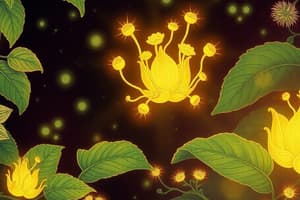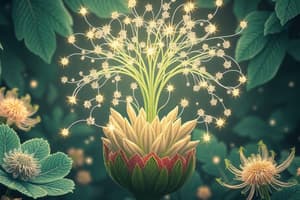Podcast
Questions and Answers
What is the primary function of the stomata in a plant?
What is the primary function of the stomata in a plant?
- To absorb light energy for photosynthesis
- To facilitate the exchange of gases and water between the plant and the environment (correct)
- To synthesize glucose during photosynthesis
- To regulate the temperature of the leaf
What is the role of the transpiration stream in photosynthesis?
What is the role of the transpiration stream in photosynthesis?
- To regulate the temperature of the plant
- To provide the necessary water for the light-dependent reactions (correct)
- To convert light energy into chemical energy
- To synthesize glucose during the Calvin cycle
Which part of the photosynthetic process involves the conversion of light energy into chemical energy?
Which part of the photosynthetic process involves the conversion of light energy into chemical energy?
- The light-dependent reactions (correct)
- The stomatal regulation
- The transpiration stream
- The Calvin cycle
What is the process by which water moves from the roots to the leaves of a plant?
What is the process by which water moves from the roots to the leaves of a plant?
What is the role of chlorophyll in photosynthesis?
What is the role of chlorophyll in photosynthesis?
What is the term for the process of water moving from an area of high concentration to an area of low concentration?
What is the term for the process of water moving from an area of high concentration to an area of low concentration?
What is the primary function of the light-dependent reactions in photosynthesis?
What is the primary function of the light-dependent reactions in photosynthesis?
In which part of the chloroplast do the Calvin cycle reactions take place?
In which part of the chloroplast do the Calvin cycle reactions take place?
What is the byproduct of the light-dependent reactions that is released into the atmosphere?
What is the byproduct of the light-dependent reactions that is released into the atmosphere?
How does water enter the plant during photosynthesis?
How does water enter the plant during photosynthesis?
What is the energy source used in the Calvin cycle?
What is the energy source used in the Calvin cycle?
What is the process by which water is transported from the roots to the leaves during photosynthesis?
What is the process by which water is transported from the roots to the leaves during photosynthesis?
Flashcards are hidden until you start studying
Study Notes
Photosynthesis: The Process of Converting Light Energy into Chemical Energy
Photosynthesis is a complex process that allows phototrophs, such as plants and certain bacteria, to convert light energy into chemical energy, which is then used for cellular activities. This process involves two main stages: the light-dependent reactions and the Calvin cycle.
Light-Dependent Reactions
The light-dependent reactions, also known as the light reactions, occur in the thylakoid membrane of chloroplasts and require a continuous supply of light energy. Chlorophylls absorb this light energy, which is converted into chemical energy through the formation of adenosine triphosphate (ATP) and nicotinamide adenine dinucleotide phosphate (NADPH). In this process, water molecules are also converted to oxygen gas, which is released as a byproduct.
Calvin Cycle
The Calvin cycle, also known as the light-independent reactions, takes place in the stroma of chloroplasts and does not directly require light. It uses the ATP and NADPH generated in the light-dependent reactions to fix carbon dioxide and produce three-carbon sugars, such as glyceraldehyde-3-phosphate (G3P). These sugars can then join together to form glucose, which is used as a source of energy for the plant.
Osmosis and Stomatal Regulation
During photosynthesis, water is absorbed by the root hairs from the soil and transported to the leaves through the xylem vessels. The stomata, small pores located on the surface of the leaves, regulate the exchange of gases and water between the plant and the environment. When the plant needs to take in carbon dioxide for photosynthesis, the stomata open, allowing carbon dioxide to enter. When the plant needs to release oxygen or water vapor, the stomata close to prevent excessive loss of these gases.
Transpiration Stream
The transpiration stream is the pathway by which water moves from the roots to the leaves of a plant. It involves the absorption of water from the soil by the roots, its transport through the xylem vessels, and its release into the atmosphere as water vapor through the stomata. The transpiration stream is an essential part of the photosynthesis process, as it provides the water necessary for the light-dependent reactions to occur.
In summary, photosynthesis is a complex process that involves the conversion of light energy into chemical energy through the light-dependent reactions and the Calvin cycle. It is facilitated by the presence of chloroplasts, which contain chlorophyll and other photosynthetic pigments. The process also relies on the regulation of water and gas exchange through the stomata, and the transpiration stream to provide the necessary water for photosynthesis.
Studying That Suits You
Use AI to generate personalized quizzes and flashcards to suit your learning preferences.





